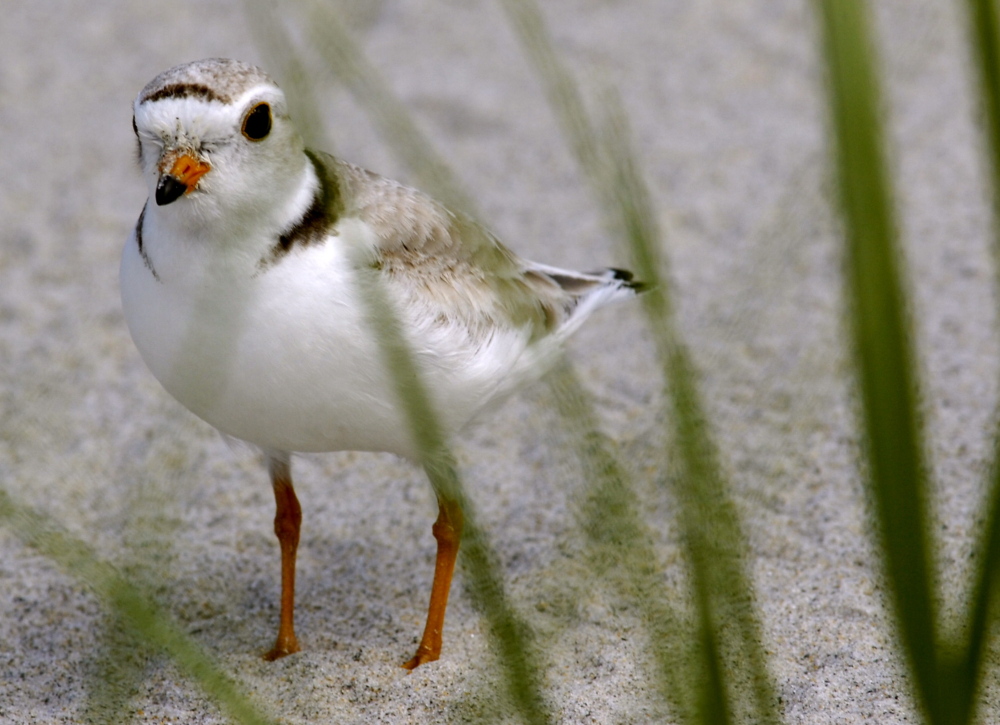Maine is on track to have the biggest flock of piping plover chicks in more than 30 years, buoying hopes for the tiny, federally protected shorebirds whose nesting habits coincide with the peak season for human beachgoers.
At least 115 piping plover chicks have fledged – developed enough to fly – so far this summer on Maine beaches, up from 97 chicks last year and the most since record keeping began in 1981. While some of those birds remain vulnerable because they are not yet strong fliers, the figures suggest that Maine’s collaborative management and monitoring system involving government agencies and large teams of volunteers is producing results.
“We still have a few more chicks on the beach, but we have hit 115 so that is great news because that is a lot of birds,” said Laura Minich Zitske, director of Maine Audubon’s piping plover and least tern project.
TENSIONS, COOPERATION
Once found throughout the Atlantic coastline, piping plovers are shore birds that measure just 7 inches long and weigh a mere 2 ounces as adults. Today the birds are listed as “threatened” under the federal Endangered Species Act and “endangered” in Maine because of a combination of habitat loss, past human hunting and predation from other animals. But because they nest and breed on sandy beaches from spring through late-summer, plovers have become a flash point of tensions over beach restrictions.
A debate raged in Scarborough in 2013 and 2014, for example, when the federal government required the town to strengthen plover protections after one of the chicks was killed by an unleashed dog. But such flare-ups are relatively uncommon in Maine. And both Zitske and shorebird biologist Lindsay Tudor with the Maine Department of Inland Fisheries & Wildlife credited the recent plover success to the collaborative relationship between their agencies, coastal towns and volunteer monitoring groups.
“We all work together and have put together this strong partnership,” said Tudor, later adding: “We would not have these birds without the local stewardship.”
Roughly 2,000 piping plover pairs nest on beaches from North Carolina to Newfoundland. The tiny birds can be spotted skittering at the ocean’s edge or on mudflats searching for worms, bugs and other invertebrates. When they aren’t foraging, plovers can be found nesting in the transition area between dunes and the sandy beach. Plover chicks are so small they are often described as cottonballs walking on toothpick legs.
In 2005, just 27 chicks fledged on Maine beaches after nests and birds were wiped out by a combination of stormy weather and increased predation. While the numbers fluctuate year to year, the trend in Maine has shown consistent growth since then. In 2013, Maine recorded 44 nesting pairs that yielded 85 fledglings followed by 50 pairs and 97 fledglings in 2014.
MONITORING, OUTREACH, PRIDE
Maine Audubon works closely with the state wildlife department and towns from Ogunquit to Georgetown to monitor the beaches for breeding pairs beginning in the spring and then advising the public about the birds’ presence. Nests with eggs are often protected by mesh fencing that allows the birds to skitter in and out of the area while keeping out predators. Volunteers and some paid beach monitors advise beach-goers and dog owners on how to avoid disturbing the sensitive birds. The U.S. Department of Agriculture’s Wildlife Services division also kills raccoons, skunks, foxes and other potential predators in some areas, particularly near plover nests in the Rachel Carson National Wildlife Refuge.
Old Orchard Beach has proven that birds and people can co-exist, even at the height of summer. Seven plover pairs successfully raised a record 16 chicks in Old Orchard from an area north of the pier to Palace Playland.
“I’d like to think our outreach efforts are really paying off because it feels different out there on the beach,” Zitske said. “People care and I think they take pride in seeing the plovers fledge off of their beaches, and there is an amazing network of volunteers out there keeping an eye on the birds.”
Other states appear to be having mixed results this year, according to preliminary assessments provided to the U.S. Fish and Wildlife Service. Connecticut reported strong productivity with potentially the highest population since plovers were added to the Endangered Species List, and plovers bred and hatched along the shores of Lake Ontario in New York for the first time in 30 years. Maryland and Delaware reported their nesting seasons had gone OK.
Tudor of the state wildlife department said Maine is currently meeting its federal goal for per-nest productivity but is still short of its goal of having 80 nesting pairs. But Tudor said the nesting-pairs goal could be lowered given the strong fledgling numbers in order to strike a proper balance – or “carrying capacity” – between the birds’ prevalence and people’s use of the beaches.
“You have a biological carrying capacity but you also have a social carrying capacity,” Tudor said. “We want people to be able to enjoy the beach as well. It is something that we need to be sensitive to.”
Send questions/comments to the editors.




Success. Please wait for the page to reload. If the page does not reload within 5 seconds, please refresh the page.
Enter your email and password to access comments.
Hi, to comment on stories you must . This profile is in addition to your subscription and website login.
Already have a commenting profile? .
Invalid username/password.
Please check your email to confirm and complete your registration.
Only subscribers are eligible to post comments. Please subscribe or login first for digital access. Here’s why.
Use the form below to reset your password. When you've submitted your account email, we will send an email with a reset code.